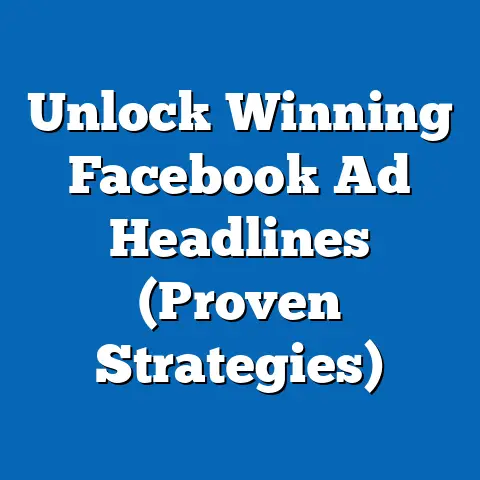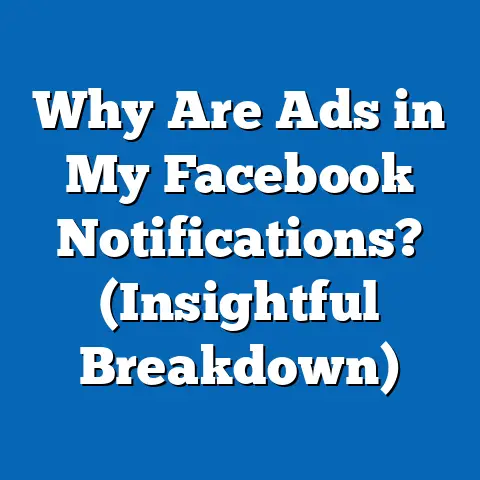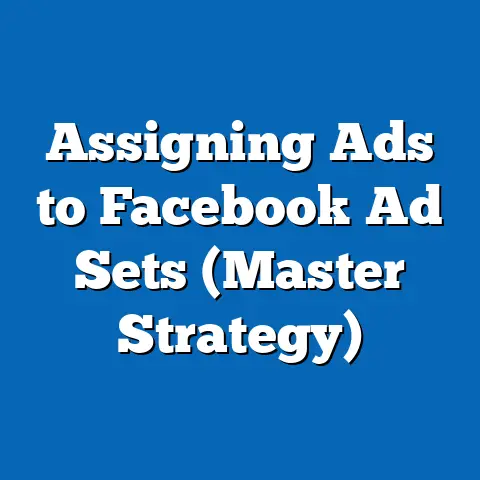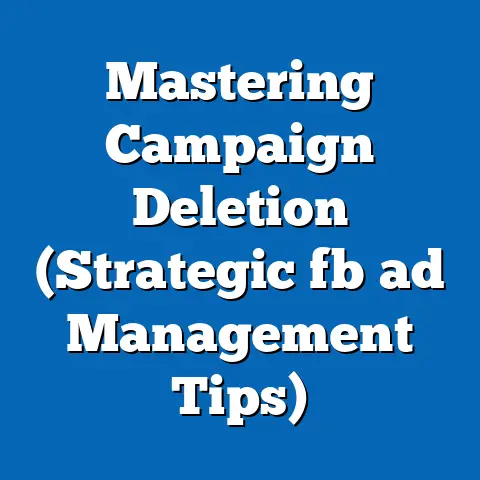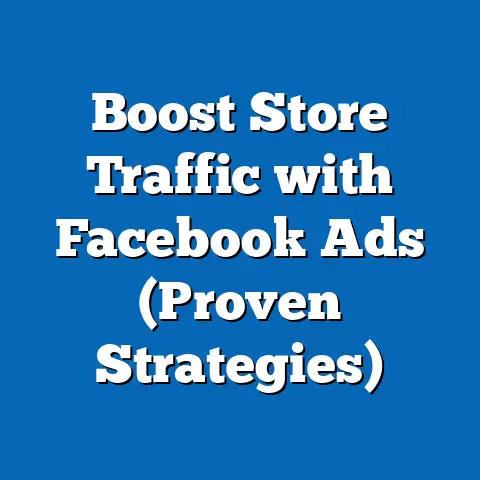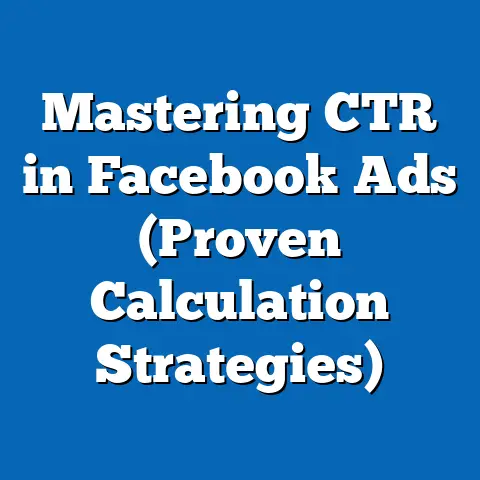Boost Back-to-School Sales (Proven fb ad Strategies)
The back-to-school season is a goldmine for retailers. It’s that time of year when parents and students alike are gearing up for a fresh start, and that means spending money on everything from pencils and notebooks to laptops and new wardrobes. As a digital marketing expert, I’ve seen firsthand how a well-executed Facebook ad campaign can make all the difference between a mediocre back-to-school season and a record-breaking one.
One of the quickest fixes I’ve seen work wonders is simply tailoring your ad copy to reflect the anxieties and excitement of the season. For example, instead of a generic “Shop Now” call to action, try something like “Gear Up for Success!” or “Ace the Semester with Our Deals!” I recall one campaign we ran for an office supply store where just changing the CTA to “Conquer the Classroom” resulted in a 20% increase in click-through rates. It’s these little tweaks that can significantly impact your ROI.
Section 1: Understanding the Back-to-School Market
Before diving into ad creation, it’s crucial to understand the landscape of the back-to-school market. What are the current trends? Who are the key demographics? What drives their purchasing decisions?
Current Trends in Back-to-School Shopping
The back-to-school shopping landscape is constantly evolving, influenced by factors like technology, economic conditions, and changing consumer preferences. As someone who has been tracking these trends for years, I can tell you that staying informed is half the battle.
- E-commerce Dominance: Online shopping continues to grow, with many consumers preferring the convenience of browsing and purchasing from home. According to the National Retail Federation (NRF), online spending for back-to-school reached record levels in recent years, and this trend is expected to continue.
- Mobile Shopping: Mobile devices are now the primary tool for many shoppers. People research products, compare prices, and make purchases directly from their smartphones. This means your Facebook ads need to be mobile-optimized.
- Value-Driven Shopping: Consumers are increasingly price-conscious, seeking deals and discounts. They are more likely to shop around and compare prices before making a purchase. I’ve noticed a significant uptick in the use of coupon codes and cashback apps during the back-to-school season.
- Sustainability and Socially Conscious Purchases: More and more consumers are considering the environmental and social impact of their purchases. Products made from sustainable materials or from companies with strong ethical practices are gaining popularity.
- Electronics and Technology: From laptops and tablets to headphones and printers, electronics are a major spending category. Many students need updated technology to succeed in their studies, making this a lucrative area for retailers.
Demographics of Back-to-School Shoppers
Understanding your audience is paramount in any marketing endeavor. In the back-to-school market, you’re primarily targeting three key demographics:
- Parents: Parents are the primary decision-makers for younger students (elementary, middle, and high school). They’re often juggling multiple responsibilities and looking for convenience and value. I remember helping a client target parents by highlighting the durability and longevity of their school supplies, which resonated strongly with their concerns about cost-effectiveness.
- Students: Older students (high school and college) often have more influence over their purchasing decisions. They’re driven by trends, peer influence, and the desire to express their individuality.
- Educators: Teachers and school administrators also spend money on classroom supplies and educational resources. Targeting educators with ads for bulk discounts or specialized products can be highly effective.
Psychological Factors Driving Purchasing Decisions
Beyond demographics, understanding the psychological factors that drive purchasing decisions can help you craft more compelling ads.
- The Fresh Start Effect: The back-to-school season represents a fresh start and a chance to set new goals. This creates a sense of optimism and motivation to invest in products that will support success.
- Social Pressure: Students often feel pressure to keep up with trends and fit in with their peers. This can drive purchases of clothing, accessories, and electronics.
- Anxiety and Preparation: Parents often feel anxious about ensuring their children are well-prepared for the school year. This can drive purchases of school supplies, study aids, and organizational tools.
- Nostalgia: For some parents, the back-to-school season evokes feelings of nostalgia for their own school days. This can influence their purchasing decisions, leading them to buy products that remind them of their childhood.
Key Takeaway: To effectively target the back-to-school market, understand the current trends, key demographics, and psychological factors that drive purchasing decisions. This knowledge will inform your ad targeting, messaging, and creative strategy.
Section 2: Crafting the Perfect Facebook Ad Campaign
Creating a successful Facebook ad campaign for back-to-school sales requires careful planning and execution. As someone who has managed countless campaigns, I can tell you that it’s not just about throwing money at ads; it’s about strategically crafting a campaign that resonates with your target audience and achieves your desired objectives.
Setting Clear Campaign Objectives
Before you start creating ads, it’s essential to define your campaign objectives. What do you want to achieve with your Facebook ads? Common objectives include:
- Brand Awareness: Increase awareness of your brand among potential customers. This is useful if you’re launching a new product or entering a new market.
- Website Traffic: Drive traffic to your website to increase product views and potential sales.
- Engagement: Encourage interaction with your brand through likes, comments, and shares. This can help build a community and increase brand loyalty.
- Lead Generation: Collect leads from potential customers for future marketing efforts. This is useful if you’re offering a free resource or running a contest.
- Conversions: Drive sales and revenue by encouraging customers to make a purchase on your website.
Your objective will influence your ad format, targeting, and bidding strategy. For example, if your objective is brand awareness, you might focus on reach and frequency, while if your objective is conversions, you’ll want to optimize for purchases.
Identifying and Segmenting Target Audiences
Facebook’s targeting capabilities are incredibly powerful, allowing you to reach specific audiences based on demographics, interests, and behaviors. Here are some ways to identify and segment your target audience for back-to-school campaigns:
- Demographics: Target parents based on age, location, education level, and parental status. You can also target students based on age, education level, and field of study.
- Interests: Target users who have shown interest in relevant topics, such as school supplies, electronics, clothing, or educational resources.
- Behaviors: Target users based on their online behavior, such as past purchases, website visits, or engagement with related content.
- Custom Audiences: Upload a list of your existing customers to create a custom audience. You can then target these customers with special offers or promotions.
- Lookalike Audiences: Create a lookalike audience based on your existing customers or website visitors. This allows you to reach new potential customers who share similar characteristics.
I’ve found that creating multiple, highly segmented audiences often yields better results than targeting one broad audience. For example, you might create separate audiences for parents of elementary school students, high school students, and college students, each with tailored ad messaging and creative.
Creating Compelling Ad Copy and Visuals
Your ad copy and visuals are what will ultimately grab the attention of your target audience and persuade them to take action. Here are some tips for creating compelling ads:
- Highlight the Benefits: Focus on the benefits of your products, not just the features. How will your products help students succeed in school? How will they make parents’ lives easier?
- Use Strong Visuals: Use high-quality images or videos that showcase your products in an appealing way. Consider using lifestyle images that show students using your products in a real-world setting.
- Write Clear and Concise Copy: Get straight to the point and use language that resonates with your target audience. Avoid jargon and focus on the key benefits.
- Include a Strong Call to Action: Tell users what you want them to do, whether it’s “Shop Now,” “Learn More,” or “Get a Discount.”
- Use Urgency: Create a sense of urgency by highlighting limited-time offers or promotions.
I once worked on a campaign for a clothing retailer where we A/B tested different ad copy. One version focused on the style and trends of the clothing, while the other focused on the comfort and durability. The version that highlighted comfort and durability outperformed the other by 30%, demonstrating the importance of understanding your audience’s priorities.
Key Takeaway: Crafting the perfect Facebook ad campaign involves setting clear objectives, identifying and segmenting your target audience, and creating compelling ad copy and visuals. Remember to focus on the benefits of your products and use strong calls to action.
Section 3: Proven Facebook Ad Strategies for Back-to-School
Now that you understand the basics of creating a Facebook ad campaign, let’s dive into some proven strategies that are particularly effective for back-to-school sales.
Subsection 3.1: Carousel Ads
Carousel ads allow you to showcase multiple products or features in a single ad unit. This is a great way to highlight a variety of back-to-school essentials or to tell a story about how your products can help students succeed.
- How Carousel Ads Work: Carousel ads consist of a series of images or videos that users can swipe through. Each image or video can have its own headline, description, and link.
- Effective Use Cases for Back-to-School Products:
- Showcase a variety of school supplies, such as notebooks, pens, and backpacks.
- Highlight different features of a laptop or tablet, such as battery life, processing power, and screen resolution.
- Tell a story about how your products can help students prepare for the school year.
- Benefits of Showcasing Multiple Products:
- Increase engagement by giving users more to explore.
- Drive more traffic to your website by linking to multiple product pages.
- Appeal to a wider range of interests and needs.
- Showcase a variety of school supplies, such as notebooks, pens, and backpacks.
- Highlight different features of a laptop or tablet, such as battery life, processing power, and screen resolution.
- Tell a story about how your products can help students prepare for the school year.
- Increase engagement by giving users more to explore.
- Drive more traffic to your website by linking to multiple product pages.
- Appeal to a wider range of interests and needs.
I remember working on a campaign for a bookstore where we used carousel ads to showcase different genres of books that were popular for back-to-school reading lists. We saw a significant increase in click-through rates and website traffic compared to using single-image ads.
Subsection 3.2: Video Ads
Video ads are incredibly powerful for capturing attention and conveying messages. They’re particularly effective for showcasing products in action or telling a compelling story.
- The Power of Video Ads: Videos are more engaging than static images and can convey more information in a shorter amount of time.
- Tips for Creating Engaging Video Content:
- Keep your videos short and to the point (ideally under 30 seconds).
- Use high-quality visuals and audio.
- Tell a compelling story that resonates with your target audience.
- Include a clear call to action.
- Highlighting Back-to-School Promotions:
- Showcase students using your products in a classroom or study setting.
- Create a time-lapse video of students getting ready for school.
- Interview students about their back-to-school goals and how your products can help them achieve those goals.
- Keep your videos short and to the point (ideally under 30 seconds).
- Use high-quality visuals and audio.
- Tell a compelling story that resonates with your target audience.
- Include a clear call to action.
- Showcase students using your products in a classroom or study setting.
- Create a time-lapse video of students getting ready for school.
- Interview students about their back-to-school goals and how your products can help them achieve those goals.
I once helped a client create a video ad that featured students unboxing their new school supplies. The video was simple but effective, and it generated a lot of excitement and engagement on Facebook.
Subsection 3.3: Dynamic Ads
Dynamic ads are personalized ads that are automatically generated based on a user’s past behavior on your website or app. This is a great way to retarget potential customers who have shown interest in specific products.
- How Dynamic Ads Work: Dynamic ads use the Facebook Pixel to track user behavior on your website. When a user views a product or adds it to their cart but doesn’t complete the purchase, a dynamic ad is automatically generated to retarget them with that specific product.
- Retargeting Potential Customers: Dynamic ads are highly effective for retargeting because they show users products they’ve already expressed interest in.
- Effectiveness of Personalized Content: Personalized ads are more likely to grab a user’s attention and drive conversions.
I’ve seen dynamic ads work wonders for e-commerce businesses, especially during the back-to-school season when parents are often browsing multiple websites for the best deals.
Subsection 3.4: Limited-Time Offers and Promotions
Creating a sense of urgency with limited-time offers and promotions can be a powerful way to boost sales during the back-to-school season.
- The Urgency Factor: People are more likely to take action when they feel like they might miss out on a good deal.
- Examples of Successful Limited-Time Offer Campaigns:
- Offer a discount or free gift for purchases made within a certain timeframe.
- Run a contest or giveaway with a limited entry period.
- Create a flash sale with deeply discounted prices for a limited time.
- Boosting Sales: Limited-time offers can create a sense of excitement and encourage customers to make a purchase sooner rather than later.
- Offer a discount or free gift for purchases made within a certain timeframe.
- Run a contest or giveaway with a limited entry period.
- Create a flash sale with deeply discounted prices for a limited time.
I always advise clients to clearly communicate the expiration date of their offers in their ad copy and visuals to maximize the sense of urgency.
Key Takeaway: Proven Facebook ad strategies for back-to-school include carousel ads for showcasing multiple products, video ads for capturing attention, dynamic ads for retargeting potential customers, and limited-time offers for creating urgency.
Section 4: Leveraging Facebook Tools and Features
Facebook offers a range of tools and features that can significantly enhance your advertising efforts. Mastering these tools is essential for maximizing your ROI.
Facebook Pixel
The Facebook Pixel is a small piece of code that you place on your website to track conversions and optimize your campaigns. It allows you to see how people are interacting with your website after clicking on your Facebook ad.
- Setting Up Facebook Pixel:
- Go to Facebook Events Manager.
- Create a new Pixel.
- Install the Pixel code on your website.
- Tracking Conversions: The Pixel tracks various events, such as page views, add-to-carts, and purchases.
- Optimizing Campaigns: Use the data collected by the Pixel to optimize your campaigns for conversions.
- Go to Facebook Events Manager.
- Create a new Pixel.
- Install the Pixel code on your website.
I always emphasize the importance of installing the Facebook Pixel as early as possible. The more data you collect, the better you can optimize your campaigns.
Lookalike Audiences
Lookalike audiences allow you to reach new potential customers who share similar characteristics with your existing customers or website visitors.
- Creating Lookalike Audiences:
- Go to Facebook Audiences.
- Create a new Lookalike Audience.
- Choose your source audience (e.g., your customer list or website visitors).
- Select the size of your lookalike audience (1-10%).
- Reaching New Potential Customers: Lookalike audiences are a great way to expand your reach and find new customers who are likely to be interested in your products.
- Go to Facebook Audiences.
- Create a new Lookalike Audience.
- Choose your source audience (e.g., your customer list or website visitors).
- Select the size of your lookalike audience (1-10%).
I’ve found that lookalike audiences based on high-value customers tend to perform the best.
A/B Testing
A/B testing allows you to test different versions of your ads to see which performs better. This is a crucial step in refining your ad strategies and improving performance.
- Refining Ad Strategies: A/B testing allows you to test different ad copy, visuals, targeting options, and bidding strategies.
- Improving Performance: By identifying which versions of your ads perform best, you can optimize your campaigns for maximum ROI.
- Using A/B Testing:
- Create two versions of your ad with one variable changed (e.g., the headline or the image).
- Run both ads simultaneously.
- Track the performance of each ad and identify which one performs better.
- Use the winning ad as the basis for future tests.
- Create two versions of your ad with one variable changed (e.g., the headline or the image).
- Run both ads simultaneously.
- Track the performance of each ad and identify which one performs better.
- Use the winning ad as the basis for future tests.
I recommend A/B testing one variable at a time to accurately determine which changes are driving the best results.
Key Takeaway: Leverage Facebook’s tools and features, such as the Facebook Pixel, Lookalike Audiences, and A/B testing, to enhance your advertising efforts and maximize your ROI.
Section 5: Measuring and Analyzing Campaign Performance
Tracking your campaign performance is essential for understanding what’s working and what’s not. By monitoring key performance indicators (KPIs), you can make informed decisions about how to optimize your campaigns.
Tracking Key Performance Indicators (KPIs)
Here are some key KPIs to track for your Facebook ad campaigns during the back-to-school season:
- Reach: The number of unique people who saw your ad.
- Impressions: The number of times your ad was displayed.
- Click-Through Rate (CTR): The percentage of people who clicked on your ad after seeing it.
- Conversion Rate: The percentage of people who completed a desired action (e.g., making a purchase) after clicking on your ad.
- Cost Per Click (CPC): The average cost you paid for each click on your ad.
- Cost Per Conversion (CPC): The average cost you paid for each conversion.
- Return on Ad Spend (ROAS): The amount of revenue you generated for every dollar you spent on advertising.
I always advise clients to set benchmarks for their KPIs before launching their campaigns so they have a clear understanding of what constitutes success.
Tools and Metrics to Measure Success
Facebook Ads Manager provides a wealth of data and reporting tools to help you track your campaign performance.
- Facebook Ads Manager: Use Facebook Ads Manager to monitor your KPIs, track your spending, and analyze your campaign performance.
- Google Analytics: Integrate Google Analytics with your Facebook campaigns to track website traffic and conversions.
Interpreting Data and Making Informed Decisions
Analyzing your data is crucial for making informed decisions about how to optimize your campaigns.
- Identify Trends: Look for trends in your data to understand what’s working and what’s not.
- Segment Your Data: Segment your data by demographics, interests, and behaviors to understand which audiences are performing best.
- Adjust Your Targeting: Adjust your targeting based on your data to focus on the audiences that are most likely to convert.
- Optimize Your Ads: Optimize your ad copy and visuals based on your data to improve your click-through rates and conversion rates.
- Adjust Your Bidding Strategy: Adjust your bidding strategy based on your data to optimize your spending.
I’ve seen campaigns transformed by simply paying attention to the data and making small adjustments based on the insights gleaned from it.
Key Takeaway: Measuring and analyzing your campaign performance is essential for understanding what’s working and what’s not. Track key KPIs, use Facebook Ads Manager and Google Analytics to monitor your data, and make informed decisions about how to optimize your campaigns.
Section 6: Case Studies of Successful Back-to-School Campaigns
To further illustrate the power of Facebook ads for back-to-school sales, let’s take a look at a few case studies of businesses that have successfully utilized this platform.
Case Study 1: Staples
Staples, a leading office supply retailer, ran a back-to-school campaign on Facebook that focused on driving traffic to their website and increasing sales of school supplies.
- Strategy: Staples used a combination of carousel ads and video ads to showcase a variety of school supplies and highlight their back-to-school promotions.
- Targeting: They targeted parents of school-aged children based on age, location, and interests.
- Results: The campaign resulted in a significant increase in website traffic and sales of school supplies.
- Key Takeaway: Use a combination of different ad formats to showcase a variety of products and highlight your promotions.
Case Study 2: Target
Target, a popular retail chain, ran a back-to-school campaign on Facebook that focused on increasing brand awareness and driving traffic to their stores.
- Strategy: Target used video ads to tell a compelling story about students getting ready for the school year and highlight the convenience of shopping at Target.
- Targeting: They targeted parents of school-aged children and college students based on age, location, and interests.
- Results: The campaign resulted in a significant increase in brand awareness and store traffic.
- Key Takeaway: Use video ads to tell a compelling story that resonates with your target audience.
Case Study 3: Best Buy
Best Buy, a leading electronics retailer, ran a back-to-school campaign on Facebook that focused on driving sales of laptops, tablets, and other electronics.
- Strategy: Best Buy used dynamic ads to retarget potential customers who had shown interest in specific products on their website.
- Targeting: They targeted users who had viewed products on their website or added them to their cart but hadn’t completed the purchase.
- Results: The campaign resulted in a significant increase in sales of laptops, tablets, and other electronics.
- Key Takeaway: Use dynamic ads to retarget potential customers who have shown interest in specific products on your website.
Key Takeaway: These case studies demonstrate the power of Facebook ads for driving traffic, increasing sales, and building brand awareness during the back-to-school season.
Conclusion
The back-to-school season is a crucial time for retailers, and Facebook ads can be a powerful tool for capturing your share of the market. By understanding the market dynamics, crafting compelling ads, leveraging Facebook’s tools, and measuring your results, you can significantly boost your back-to-school sales.
Remember, the key is to start early, test different strategies, and continuously optimize your campaigns based on data and insights. And always, always, tailor your messaging to resonate with the specific needs and anxieties of your target audience during this unique time of year.
I encourage you to implement these strategies promptly to maximize your success during this critical shopping period. Good luck, and may your back-to-school season be your best yet!

